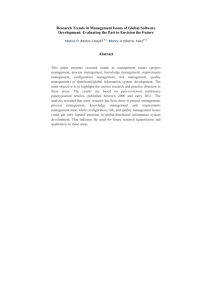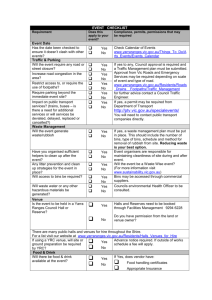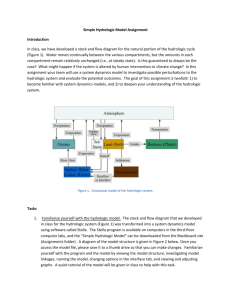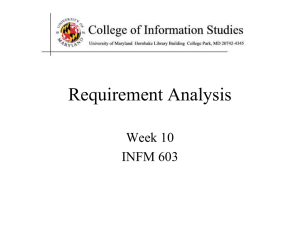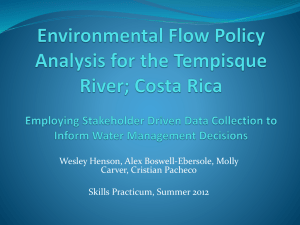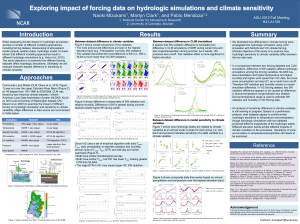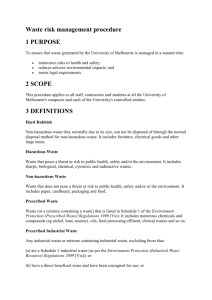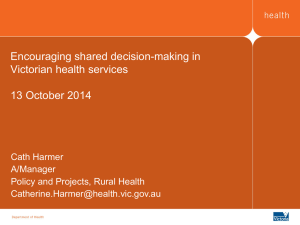Document
advertisement
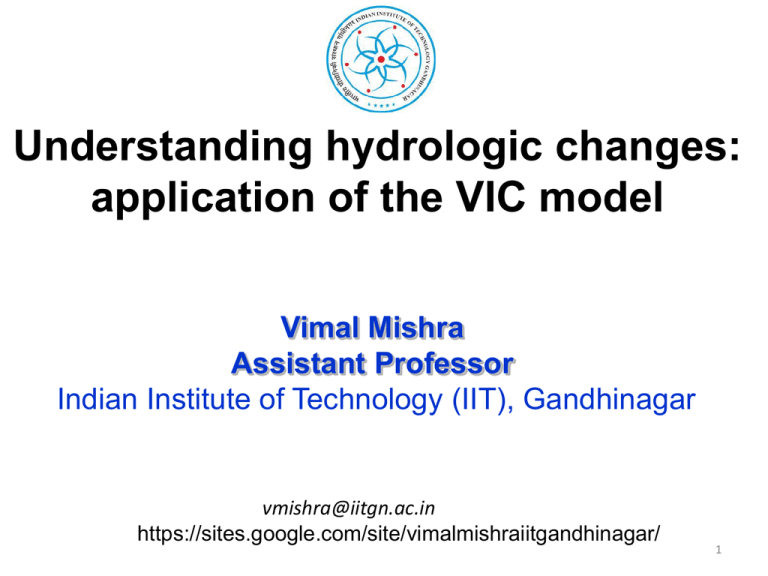
Understanding hydrologic changes:
application of the VIC model
Vimal Mishra
Assistant Professor
Indian Institute of Technology (IIT), Gandhinagar
vmishra@iitgn.ac.in
https://sites.google.com/site/vimalmishraiitgandhinagar/
1
Climate Change and Water
Resources
• Water is in the eye of climate management storm
(IPCC, 2007)
• Global warming and related climate changes are
expected to present significant challenges over the
next century
• The impacts of climate change on water resource:
a) Quantity- less or more
b) Extremes – droughts and floods
c) Frequency- intensified challenges
2
Science Questions
• How have hydrologic conditions associated with soil
moisture, evapotranspiration, groundwater, snow
cover, and streamflow changed during the last 50
years?
• How will water availability and water storage change
in space and time under the projected future climate
change?
• Will hydrologic extremes be more frequent, wide
spread, and more intense?
s3
Key Impacts
• Surface water [ streamflow, soil moisture, ET, Snow
and Glaciers levels of reservoirs/lakes]
• Groundwater [recharge rates, groundwater table]
• Droughts [ indicators, areal extents, severity, and
frequency]
• Floods [return levels, flash flooding, damage to
infrastructure]
• Key areas [ Agriculture, Hydropower, Water Storage
and Water Availability]
4
Hydrologic Modeling of Climate
Change Impacts
• Climate forcing (spatial resolution)
• Data for calibration and evaluation (groundwater,
surface water, water quality)
• Land use/land cover projections
• Cropping systems/patterns and irrigation demands
• Water management and reservoir operations
• Evaluation of uncertainty
5
THE VARIABLE INFILTRATION CAPACITY
(VIC) MODEL
Liang et al. (1994), Cherkauer et al., 2003
Mishra et al., 2010; Mishra and Cherkauer, 2010
The VIC model: Main Features
The VIC model (Liang et al. 1994) is a large scale
semi-distributed model
It has several features that are common to other land
surface models (LSMs) used in the global climate
models (GCMs)
The land surface is modeled using the large ( > 1 km)
flat grid cells
Sub-grid heterogeneity (elevation, land cover) is
handled using statistical distributions
7
Meteorological Forcing
Can use any combination of daily or sub-daily meteorogolical
forcings, from point observations, gridded observations, or
reanalysis fields
At minimum, VIC requires daily {precipitation, max/min air
temperature, and wind speed}
If incoming shortwave radiation or humidity are not supplied
as forcings, VIC can estimate them via the algorithms of
Kimball et al. (1997), Thornton and Running (1999), and
Thornton et al. (2000)
VIC can disaggregate daily forcings to sub-daily as needed
(further details available in Bohn et al., 2012b)
8
Running the VIC Model
Basin delineation
Prepare input files ( meteorological data, soil,
vegetation parameters)
Compilation of code (written in C language)
Running VIC for the basin of interest
Output variables at each grid cell
Use Routing model to rout flow at the location of
interest
9
Representation of Various
Components
Lakes and Wetlands
Irrigation
Reservoirs
Groundwater
Cold Season Process ( soil frost, snow, and glaciers)
Applications:
Monitoring and Prediction
Climate Change Impacts
Impacts of Land Cover and Land Use
Human Modifications ( Irrigation, reservoirs etc)
Groundwater Conditions
Colorado Basin
Rosenberg et al., 2012
11
Irrigation and Reservoir
Irrigated Area
Change in Evapotranspiration (ET)
Haddland et al. (2007)
12
Application: Drought Monitoring and
Prediction
Mishra (in review)
Application: Retrospective Analysis
Mishra et al. (in revision)
Application: Streamflow Forecasting
Role of Data Assimilation in real time forecast
Observed
No Assimilation
With Assimilation
Mishra et al. (2011)
Climate Change: how reliable are the GCMs?
Ensemble Mean Percentage Bias (1961-1990)
Precipitation
Temperature
Mishra (in preparation)
HOW RELIABLE ARE GCMS?
Mishra (in preparation)
Model Simulations Using Bias
Corrected Data
Bias Corrected and Spatial Downscaling (BCSD) Approach (Wood et al., 2002; 2004)
Monsoon Season (JJAS)
18
Hydrologic Impacts of
Climate Change
Multimodel Ensemble Mean Change for the Near (2010-2039)
Hydrologic Impacts of
Climate Change
Multimodel Ensemble Mean Change for the Near (2010-2039)
Hydrologic Impacts of
Climate Change
Multimodel Ensemble Mean Change for the Mid (2040-2069)
